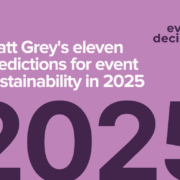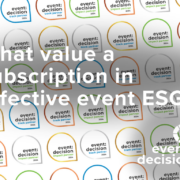Question Time continued… (EIN-style)
Event Industry News Sustainable Events Guide Launch
This week we are covering the last four of the eight topics from questions put to the panel at the Event Industry News annual Event Sustainability Breakfast Briefing.
- Measuring impact and proving sustainability efforts
- Selecting sustainable suppliers and venues
- Executing sustainable events in practice
- Addressing policy, regulation, and accountability
Here are the final selection of questions we didn’t manage to discuss – and event:decision’s (short!) associated thoughts:
5. Measuring impact and proving sustainability efforts
Tracking & Reporting Sustainability Metrics
- How can we efficiently measure the impact of events? The first is to look at the carbon footprint of your event (& you really should include delegate travel in this piece). Either subscribe to a platform and input the data or push the job to event:decision’s Track, the #1 service globally. Second way is to undertake an Impact: Responsible Event Review – the ONLY tool that allows you a checklist across the whole of ESG, with embedded sustainable suppliers, event scorecards and event team performance.
- What are the most effective and accessible methods for tracking and reporting sustainability? See above for that…
- What key metrics and reporting frameworks should event organisers prioritise to measure real impact? In carbon terms, targets are longer-term than event-by-event & include various net-zero frameworks such as Science-based Target Initiatives (SBTi). In wider sustainability, Impact: Responsible Event Reviews benchmark your event and team performance against industry sector mean performance.
- How can we improve carbon tracking and ensure accurate offsetting in the exhibition industry? In short, measure. If you are a stand/booth owner it’s simple enough to report the carbon footprint yourself, with an online tool or a service such as event:decision’s Track Reporting. If you’re a show or portfolio-owner, ask event:decision, we have tried & trusted methods to report the impact of your whole show, from space-only to visitor travel. Don’t forget the SOCIAL value of holding a show as well!
6. Sustainable Venue & Supplier Selection
Choosing the Right Suppliers & Venues
- Are sustainability accreditations important to clients, and if so, which ones? Take a look at the data in the event:decision & micebook’s Most Sustainable Agencies recognition programme. Plenty of data on accreditations.
- What is your definition of green venues? Venues can usually demonstrate environmental sustainability in a number of ways, accreditations such as Green Key & many others. Issue is, you can host a pretty low-carbon event at most venues and a pretty high-carbon event at the same venues, it all depends on the travel factor. Suggestion is that agencies – you concentrate on the elements you can control & try to select venues accessible to the audience – Venues, work hard on the factors you can control. Don’t forget, venues, you can make a REAL DIFFERENCE in social value with links to local sustainable supply and communities.
- How can historic venues balance sustainability with the constraints of listed building status? Pretty hard to get around listed status, just ask BMA House, but you can work on innovations in service, such as the weekly menus BMA House offer as part of the meeting proposition.
- What key criteria should event planners look for when selecting a green venue? Above all, search for and select a suitable venue that is accessible to your audience geographically. Then filter by proposition, see above for accreditations.
7. Sustainable Event Execution: Practical Steps
Reducing Waste & Circular Economy
- How do you avoid unnecessary waste after an event such as an exhibition? Three ways:
- Design out unnecessary waste in terms of re-usability, material and supply-chain. Ask your builder(s) how & what they will do with materials post event. We’re living in a dreamland if we think all materials can be infinitely re-used, brands require more flexibility in terms of visual approach and messaging.
- Put the end-of-life channel for the stand/booth/materials you commission into your contract. If you want to audit your supplier post-event, please do. Yes, this will take time, but if they’re a trusted and regular supplier you’ll have good reason to visit with them regardless.
- Measure both the carbon footprint of the stand & the social impact. You will see incremental improvements YOY if you action (1) & (2) above.
- How can we promote a circular approach in events? If you can’t reuse materials created for specific events, look to Event Cycle and Used Creative.
- What are your top tips to enhance sustainability and circularity for a global exhibition client? See above
- What are some quick wins for a production company to maintain an eco-friendly service? Think cleverly about materials. It is possible to reduce the carbon impact of the same programme by 50% between Yr 1 and Yr 2. We have clients who have demonstrated this. After that it can become harder. Use local crew. The largest carbon factor in nearly ALL expo stands is the travel associated with both brand staff and build crew. At least you can try to source the general crew locally.
Food, Travel & Merchandise Impact
- How do you support event clients in measuring travel and transport impacts? With the #1 global event carbon footprint service, Track, which has an automated link within to the market-leading platform to capture and produce low carbon travel plans from You.Smart.Thing.
- What is the best way to represent carbon savings per meal type at events? We often advise clients to put plant-based options at the top of the menu – proven to increase uptake. We also encourage chefs to indicate low-carbon options in the same way as chilli-heat & or calories on many menus.
- What are the best ways to promote sustainable travel to events? Select a venue that is accessible via public transport. Consider subsidising or enhancing public travel options. Use a Travel Tool such as within Track.
8. Policy, Regulation & Industry Accountability
Regulatory Challenges & Avoiding Greenwashing
- Will governments set targets for organisations to improve their sustainability impact? Not in the short term, no. The EU is re-looking at company carbon emissions reporting as we speak in early 2025, update due May-25. In the US, it’s a different story, for now. Main pressure to deliver responsibly and sustainably comes from within companies, brand values and customer demand.
- How do we ensure sustainability remains a priority despite regulatory rollbacks? Keep pushing for sustainable events, if you’re a corporate, a brand, an agency or a venue. For now, it’s still a commercial advantage. The main driver for sustainable behaviour is customer demand. This really is up to us all as consumers, vote with your wallet.
- How can we differentiate truly sustainable brands from greenwashing competitors? In the event world there is little external comparison of clients’ events due to commercial sensitivities. There are many brands espousing sustainability accreditations at Board level, whilst delivering clearly unsustainable event programmes, all with agency and supplier support. If you’re brave, call them out. At present the best indicator is within ‘agency-land’ is this. Check for accreditations, they hopefully have stringent compliance criteria.
- How can businesses balance profitability with sustainable practices? Without sustainability (Environmental, Social and Governance) there is little point in profit, an unsustainable business is by definition, a fairly short term endeavour. If one means purely environmental sustainability, this is a vital issue that the event sector needs to address. One cannot produce live events with no impact. The larger the event, the larger the impact.
- Is sustainability a threat to the event sector? Absolutely not. It’s the largest opportunity we’ve had in a generation.
Sustainability in the events industry isn’t just a challenge, it’s an opportunity. By prioritising impact measurement, responsible supplier choices, waste reduction, and proactive policy engagement, we can build a more sustainable future for events. The insights shared at the Event Industry News Breakfast Briefing highlight that while there’s still work to do, practical solutions are already within reach. The real question is: how will you take action?










